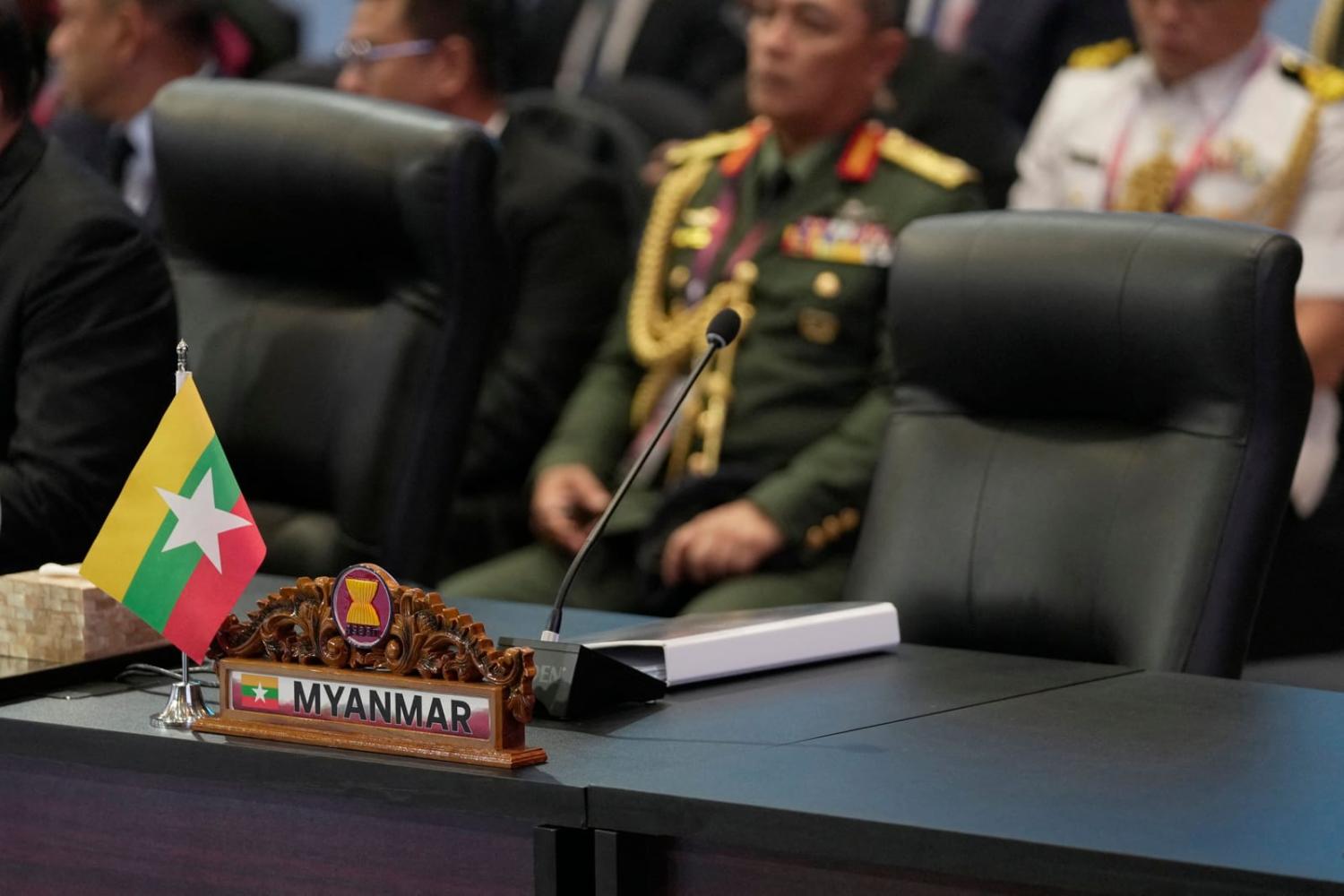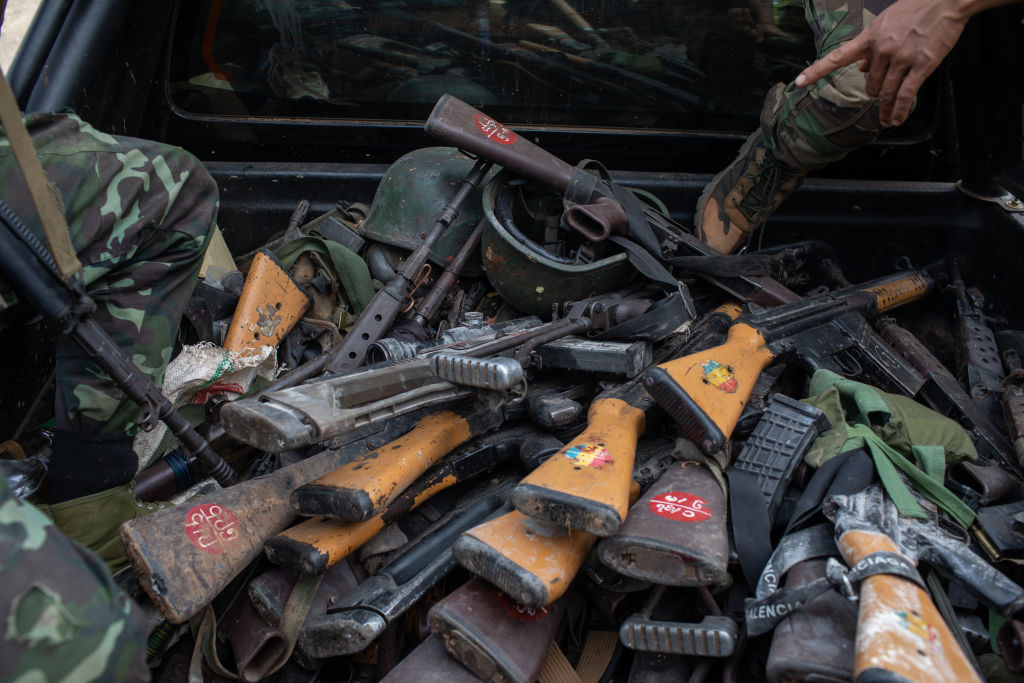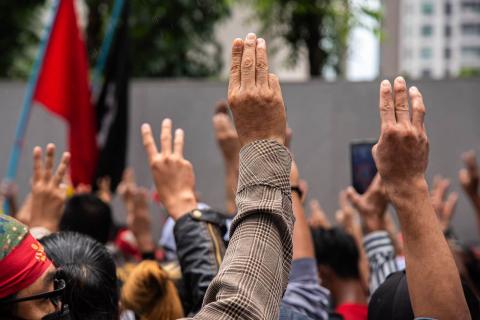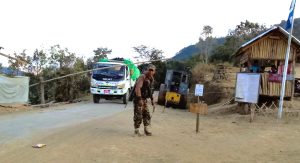The rebels appear to hold all the initiative on the battlefield.

There is little love for the generals among the population
(Dita Alangkara via AFP/Getty Images)
Myanmar
The latest phase of military conflict in Myanmar pitting rebel forces against the Myanmar military, better known as the Tatmadaw, may herald a new political and security landscape in the war-torn Southeast Asian country.
Since October, three ethnic armed organisations under the banner of the Three Brotherhood Alliance have launched a coordinated offensive against the ruling military junta. Codenamed Operation 1027, the campaign has included the Ta’ang National Liberation Army, the Myanmar National Democratic Alliance Army, and the Arakan Army, targeting Tatmadaw’s controlled areas and military outposts.
The success of the coordinated offensive has drawn support from other rebel forces among the milieu of local groups opposed to the regime, with the People’s Defence Force and the Communist Party of Burma’s People’s Liberation Army stepping up their fight against the Tatmadaw. In the past month, different rebel forces have overrun junta outposts and captured large swathes of land, including several towns and border crossings with India and China.
But two main factors will answer the question about how this latest fighting might shape the outcome of the battle against the junta: first, whether the rebel forces can maintain the pace of the offensive; second, how effectively the Tatmadaw can regroup with a counter-offensive.
There are reports of Tatmadaw units surrendering without fighting or offering only feeble resistance before giving up.
There are several indicators suggesting that the rebels hold advantages on the battlefield. Given the junta’s brutality, the rebels can expect to draw on popular support. The local population is critical in any insurgency campaign, as it can lead to tangible support such as intelligence, materials, and personnel.
Since the February 2021 coup, the junta has imprisoned nearly 20,000 people and caused nearly one million people to be internally displaced. The junta’s four-cuts strategy to stifle opposition terrorises the civilian population. To maintain power, the junta has unleashed its air force to strike against civilian targets, so there is little love for the generals.
Furthermore, the rebel’s rapid success in capturing several Tatmadaw outposts has enabled them to access additional weapons and ammunition. The latest pictures and videos from social media indicate that rebel forces have also captured armoured vehicles and artillery pieces. These could be turned against the Tatmadaw in future offensives.
The latest phase of military conflict in Myanmar pitting rebel forces against the Myanmar military, better known as the Tatmadaw, may herald a new political and security landscape in the war-torn Southeast Asian country.
Since October, three ethnic armed organisations under the banner of the Three Brotherhood Alliance have launched a coordinated offensive against the ruling military junta. Codenamed Operation 1027, the campaign has included the Ta’ang National Liberation Army, the Myanmar National Democratic Alliance Army, and the Arakan Army, targeting Tatmadaw’s controlled areas and military outposts.
The success of the coordinated offensive has drawn support from other rebel forces among the milieu of local groups opposed to the regime, with the People’s Defence Force and the Communist Party of Burma’s People’s Liberation Army stepping up their fight against the Tatmadaw. In the past month, different rebel forces have overrun junta outposts and captured large swathes of land, including several towns and border crossings with India and China.
But two main factors will answer the question about how this latest fighting might shape the outcome of the battle against the junta: first, whether the rebel forces can maintain the pace of the offensive; second, how effectively the Tatmadaw can regroup with a counter-offensive.
There are reports of Tatmadaw units surrendering without fighting or offering only feeble resistance before giving up.
There are several indicators suggesting that the rebels hold advantages on the battlefield. Given the junta’s brutality, the rebels can expect to draw on popular support. The local population is critical in any insurgency campaign, as it can lead to tangible support such as intelligence, materials, and personnel.
Since the February 2021 coup, the junta has imprisoned nearly 20,000 people and caused nearly one million people to be internally displaced. The junta’s four-cuts strategy to stifle opposition terrorises the civilian population. To maintain power, the junta has unleashed its air force to strike against civilian targets, so there is little love for the generals.
Furthermore, the rebel’s rapid success in capturing several Tatmadaw outposts has enabled them to access additional weapons and ammunition. The latest pictures and videos from social media indicate that rebel forces have also captured armoured vehicles and artillery pieces. These could be turned against the Tatmadaw in future offensives.

Military weapons said to be confiscated by an armed group in Loikaw, Karenni State, 14 November
(Myo Satt Hla Thaw via Getty Images)
And the rebel forces have the initiative on the battlefield. The Tatmadaw has been forced to give up numerous positions and retreat across multiple fronts. Having the initiative is critical – military theory argues that freedom of action forces the enemy to conform to one’s objective and pace.
But theory can wilt when confronted by reality. Can the Tatmadaw regain the initiative to organise an effective defence, followed by counterattacks to recapture lost territory? For now, this seems an impossible task.
The Tatmadaw appears overstretched. Besides engaging the rebels, the junta has to contend with anti-junta forces in areas under its control, demonstrated by the reported assassination of one of the junta’s cronies in Yangon. A recent study estimated the strength of the Tatmadaw to be about 150,000 personnel, with 70,000 of them in combat units. To put the figures into context, the United States deployed nearly half-a-million troops in Vietnam at the height of the Vietnam war. Even allowing that the two conflicts are not perfect historical comparisons, it helps to illustrate the scale of the junta’s challenge. Considering that Myanmar is geographically larger than Vietnam and dotted by thick jungles and mountains, the Tatmadaw is struggling against a simultaneous fight against rebel forces throughout the country.
Low morale is also evident. There are reports of Tatmadaw units surrendering without fighting or offering only feeble resistance before giving up. In other instances, Tatmadaw troops abandoned their posts and fled to neighbouring India. Recruitment to replenish losses is also a significant problem.
As the Tatmadaw losses mount, it may retreat to major population centres and military bases. The rebel forces, controlling much of the countryside, will likely be able to isolate Tatmadaw units defending these areas. The junta may use its airpower to push back the rebels, but airpower alone is insufficient to win an insurgency. Again, the Vietnam experience is illustrative – the United States dropped more than 5 million tonnes of bombs on Vietnam but still lost the war.
The junta could be staring at defeat should the rebel push continue. Been compelled to negotiate for a peaceful power transfer is far preferable to a drawn-out fight only to be overthrown. Myanmar has known bloodshed enough. The country deserves a chance for democracy to flourish.
RELATED CONTENT

ASEAN governments need to act on Myanmar
And the rebel forces have the initiative on the battlefield. The Tatmadaw has been forced to give up numerous positions and retreat across multiple fronts. Having the initiative is critical – military theory argues that freedom of action forces the enemy to conform to one’s objective and pace.
But theory can wilt when confronted by reality. Can the Tatmadaw regain the initiative to organise an effective defence, followed by counterattacks to recapture lost territory? For now, this seems an impossible task.
The Tatmadaw appears overstretched. Besides engaging the rebels, the junta has to contend with anti-junta forces in areas under its control, demonstrated by the reported assassination of one of the junta’s cronies in Yangon. A recent study estimated the strength of the Tatmadaw to be about 150,000 personnel, with 70,000 of them in combat units. To put the figures into context, the United States deployed nearly half-a-million troops in Vietnam at the height of the Vietnam war. Even allowing that the two conflicts are not perfect historical comparisons, it helps to illustrate the scale of the junta’s challenge. Considering that Myanmar is geographically larger than Vietnam and dotted by thick jungles and mountains, the Tatmadaw is struggling against a simultaneous fight against rebel forces throughout the country.
Low morale is also evident. There are reports of Tatmadaw units surrendering without fighting or offering only feeble resistance before giving up. In other instances, Tatmadaw troops abandoned their posts and fled to neighbouring India. Recruitment to replenish losses is also a significant problem.
As the Tatmadaw losses mount, it may retreat to major population centres and military bases. The rebel forces, controlling much of the countryside, will likely be able to isolate Tatmadaw units defending these areas. The junta may use its airpower to push back the rebels, but airpower alone is insufficient to win an insurgency. Again, the Vietnam experience is illustrative – the United States dropped more than 5 million tonnes of bombs on Vietnam but still lost the war.
The junta could be staring at defeat should the rebel push continue. Been compelled to negotiate for a peaceful power transfer is far preferable to a drawn-out fight only to be overthrown. Myanmar has known bloodshed enough. The country deserves a chance for democracy to flourish.
RELATED CONTENT

ASEAN governments need to act on Myanmar
China Coy on Support for Rebels Fighting Guerrilla War on Border
Morgan Michaels, a research fellow at the International Institute for Strategic Studies think tank outlined advancements made by rebel groups in their offensive against the country's military junta.
"On 27 October, three ethnic armed groups, known as the Brotherhood Alliance, launched a large-scale, coordinated offensive against military, police, and militia targets across northern Shan State," Michaels wrote.
The offensive marked their involvement in the post-coup conflict—begun as a response to the overthrow in 2021 of Aung San Suu Kyi's democratically elected government—challenging Myanmar's military government.
"Beijing may also be behind the rise of some new armed groups, such as the People's Liberation Army, an apparent reboot of the former Communist Party of Burma," Michaels said of China's potential backing of new armed groups.
The involvement suggests a more complex relationship between China and the rebel groups in Myanmar than had previously been understood, one in which Beijing had a broader strategic calculus.
"China appears willing to endure increased border instability in the short term to secure its long-term economic and strategic interests," Michaels said.
Sign up for Newsweek’s daily headlines
"Within just two weeks, the alliance, which includes the Myanmar National Democratic Alliance Army, Ta'ang National Liberation Army, and Arakan Army, captured over 100 regime positions and gained control of several towns, including key border crossings with China," he wrote.
It was unclear, however, whether Beijing considered the groups' significant and rapid gains.
Avinash Paliwal, a Reader in International Relations at SOAS, University of London, told Newsweek in a recent interview that Myanmar's civil war began as a "parochial interest" for neighboring China, but that it had since become more complex—not necessarily in the Chinese leadership's favor.

Dec 03, 2023
By Aadil Brar
China News Reporter
By Aadil Brar
China News Reporter
NEWSWEEK
China's involvement in Myanmar's internal conflict, particularly with certain ethnic rebel groups, may have become a strategic tool for Beijing to counter online scam operations originating from the country.
While China does not officially support these groups, their alliance has been instrumental in Beijing's crackdown on scams targeting Chinese citizens. Chinese officials, however, have not been forthcoming about their aims.
"Myanmar's most powerful ethnic armed organization, the United Wa State Army, has expelled two top officials wanted by Beijing for involvement in online scams targeting Chinese citizens," according to AFP.
The move by a significant rebel group in Myanmar indicated a level of cooperation with Chinese authorities against cybercrimes.
China's involvement in Myanmar's internal conflict, particularly with certain ethnic rebel groups, may have become a strategic tool for Beijing to counter online scam operations originating from the country.
While China does not officially support these groups, their alliance has been instrumental in Beijing's crackdown on scams targeting Chinese citizens. Chinese officials, however, have not been forthcoming about their aims.
"Myanmar's most powerful ethnic armed organization, the United Wa State Army, has expelled two top officials wanted by Beijing for involvement in online scams targeting Chinese citizens," according to AFP.
The move by a significant rebel group in Myanmar indicated a level of cooperation with Chinese authorities against cybercrimes.
Morgan Michaels, a research fellow at the International Institute for Strategic Studies think tank outlined advancements made by rebel groups in their offensive against the country's military junta.
"On 27 October, three ethnic armed groups, known as the Brotherhood Alliance, launched a large-scale, coordinated offensive against military, police, and militia targets across northern Shan State," Michaels wrote.
The offensive marked their involvement in the post-coup conflict—begun as a response to the overthrow in 2021 of Aung San Suu Kyi's democratically elected government—challenging Myanmar's military government.
"Beijing may also be behind the rise of some new armed groups, such as the People's Liberation Army, an apparent reboot of the former Communist Party of Burma," Michaels said of China's potential backing of new armed groups.
The involvement suggests a more complex relationship between China and the rebel groups in Myanmar than had previously been understood, one in which Beijing had a broader strategic calculus.
"China appears willing to endure increased border instability in the short term to secure its long-term economic and strategic interests," Michaels said.
Sign up for Newsweek’s daily headlines
"Within just two weeks, the alliance, which includes the Myanmar National Democratic Alliance Army, Ta'ang National Liberation Army, and Arakan Army, captured over 100 regime positions and gained control of several towns, including key border crossings with China," he wrote.
It was unclear, however, whether Beijing considered the groups' significant and rapid gains.
Avinash Paliwal, a Reader in International Relations at SOAS, University of London, told Newsweek in a recent interview that Myanmar's civil war began as a "parochial interest" for neighboring China, but that it had since become more complex—not necessarily in the Chinese leadership's favor.

Chinese navy personnel aboard the the Chinese frigate Xiangtan, belonging to the People's Liberation Army Navy 23rd Escort Task Group, stand at attention during a departure ceremony at Thilawa port in the outskirts of Yangon on October 4, 2016. A 700-strong force from the PLA Navy called on Myanmar in late November, in a visit Beijing said was unrelated to the neighboring country's internal conflict.
ROMEO GACAD/AFP VIA GETTY
China's own People's Liberation Army (PLA) Navy deployed naval assets to Myanmar late last month. The destroyer Zibo, frigate Jingzhou and supply ship Qiandaohu arrived with about 700 sailors on November 27.
Beijing said the four-day visit was unrelated to the neighboring country's internal conflict.
The Chinese military recently carried out military drills near the southern border with Myanmar, according to images released last week. China's Defense Ministry said the exercises were routine.
"The recent combat training activity by Southern Theater Command aims to test the troops' rapid maneuverability, border sealing and control, and firepower strike capabilities to maintain security and stability in border areas," said Beijing's defense spokesperson Col. Wu Qian.
"The Chinese military has always maintained a high degree of alert and will always be prepared to respond to various emergencies," Wu said.
On Wednesday, Chinese Foreign Ministry spokesperson Wang Wenbin was asked about Beijing's support for the rebel offensive. He said: "China has always respected Myanmar's sovereignty and territorial integrity, sincerely hoped for stability and development, and firmly supported Myanmar in advancing the peace process."
"Any attempt to sow discord" or undermine the relationship wouldn't succeed, Wang said..
China's own People's Liberation Army (PLA) Navy deployed naval assets to Myanmar late last month. The destroyer Zibo, frigate Jingzhou and supply ship Qiandaohu arrived with about 700 sailors on November 27.
Beijing said the four-day visit was unrelated to the neighboring country's internal conflict.
The Chinese military recently carried out military drills near the southern border with Myanmar, according to images released last week. China's Defense Ministry said the exercises were routine.
"The recent combat training activity by Southern Theater Command aims to test the troops' rapid maneuverability, border sealing and control, and firepower strike capabilities to maintain security and stability in border areas," said Beijing's defense spokesperson Col. Wu Qian.
"The Chinese military has always maintained a high degree of alert and will always be prepared to respond to various emergencies," Wu said.
On Wednesday, Chinese Foreign Ministry spokesperson Wang Wenbin was asked about Beijing's support for the rebel offensive. He said: "China has always respected Myanmar's sovereignty and territorial integrity, sincerely hoped for stability and development, and firmly supported Myanmar in advancing the peace process."
"Any attempt to sow discord" or undermine the relationship wouldn't succeed, Wang said..
Where the Myanmar Junta Fears To Tread
Visits to four different locations in Myanmar, all in varying stages of control by resistance groups.
By Rajeev Bhattacharyya
December 01, 2023

A Chin National Army checkpoint on the road between Camp Victoria and Thantlang in Myanmar’s Chin State.Credit: Rajeev Bhattacharyya
Myanmar military chief Min Aung Hlaing admitted in February 2023 that the regime only has full control of 198 of Myanmar’s 330 townships. Martial law has been imposed in 50 townships across Yangon, Mandalay, Sagaing and Magwe regions, as well as Chin and Kayah states, where the junta is fighting for control with resistance forces. In other areas, the junta has no meaningful presence at the moment. These are the regions considered “liberated zones” by the opposition, where an alternate administration, including education and health facilities, have been erected by the National Unity Government (NUG) and local groups.
The military regime’s position in the ongoing war has further deteriorated in the nine months since the junta chief’s admission. In late October, Operation 1027 was executed by a conglomerate of three ethnic armed organizations (EAOs) called the Brotherhood Alliance. The military offensive swept across northern Shan State, resulting in the capture of 126 military bases, 13 towns, the highways leading to the China-Myanmar border towns of Muse and Chinshwehaw, and an entire battalion. Sooner thereafter, in mid-November, another military offensive began in Rakhine State.
Some among the resistance groups active along the India-Myanmar border region are optimistic about the operation being extended to their areas in Sagaing Region and Chin State, which have been among the most affected zones in the conflict. True to their expectations, regime forces were driven out of Khampat early in November by a combined offensive executed by several groups.
Between January and March, The Diplomat covertly visited Haimual-New Haimual, Thantlang, Kalay, and Tamu in Chin State and Sagaing Region to gather information on the Spring Revolution. The conflict has developed its own characteristics in each locale, with the rebel groups and the military also adopting diverse tactics to clinch a victory. There are liberated zones where the junta does not have a presence and also areas where both sides are engaged in brutal contests for control of more territory.
Visits to four different locations in Myanmar, all in varying stages of control by resistance groups.
By Rajeev Bhattacharyya
December 01, 2023

A Chin National Army checkpoint on the road between Camp Victoria and Thantlang in Myanmar’s Chin State.Credit: Rajeev Bhattacharyya
Myanmar military chief Min Aung Hlaing admitted in February 2023 that the regime only has full control of 198 of Myanmar’s 330 townships. Martial law has been imposed in 50 townships across Yangon, Mandalay, Sagaing and Magwe regions, as well as Chin and Kayah states, where the junta is fighting for control with resistance forces. In other areas, the junta has no meaningful presence at the moment. These are the regions considered “liberated zones” by the opposition, where an alternate administration, including education and health facilities, have been erected by the National Unity Government (NUG) and local groups.
The military regime’s position in the ongoing war has further deteriorated in the nine months since the junta chief’s admission. In late October, Operation 1027 was executed by a conglomerate of three ethnic armed organizations (EAOs) called the Brotherhood Alliance. The military offensive swept across northern Shan State, resulting in the capture of 126 military bases, 13 towns, the highways leading to the China-Myanmar border towns of Muse and Chinshwehaw, and an entire battalion. Sooner thereafter, in mid-November, another military offensive began in Rakhine State.
Some among the resistance groups active along the India-Myanmar border region are optimistic about the operation being extended to their areas in Sagaing Region and Chin State, which have been among the most affected zones in the conflict. True to their expectations, regime forces were driven out of Khampat early in November by a combined offensive executed by several groups.
Between January and March, The Diplomat covertly visited Haimual-New Haimual, Thantlang, Kalay, and Tamu in Chin State and Sagaing Region to gather information on the Spring Revolution. The conflict has developed its own characteristics in each locale, with the rebel groups and the military also adopting diverse tactics to clinch a victory. There are liberated zones where the junta does not have a presence and also areas where both sides are engaged in brutal contests for control of more territory.
Read the full story here, in The Diplomat magazine.

CONTRIBUTING AUTHOR
Rajeev Bhattacharyya is a senior journalist in Assam in India’s northeast

CONTRIBUTING AUTHOR
Rajeev Bhattacharyya is a senior journalist in Assam in India’s northeast
No comments:
Post a Comment